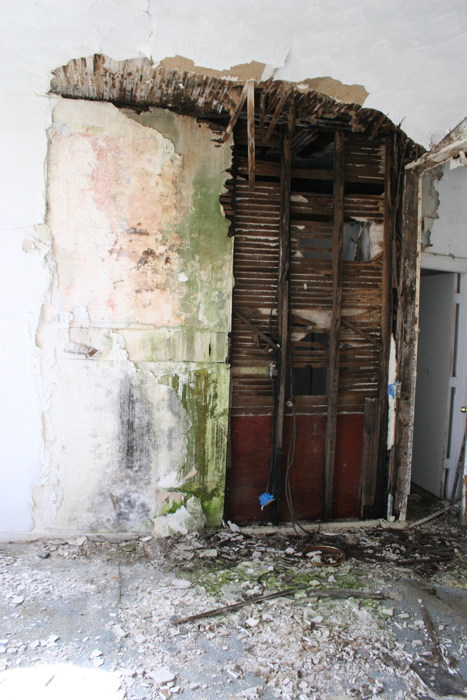Fear and Self-Loathing in the American Rust Belt
Rust Wire’s Angie Schmitt wrote an article yesterday about the problematic language of “Rust Belt chic,” a term that has been applied to the positive movement embracing narratives which are variously post-industrial, Midwestern, and urban, as they somehow relate to the decline and rebirth of cities like Detroit or Cleveland—a term that is also the title of a book on Cleveland released by Anne Trubek and Richey Piiparinen. Problematic? Perhaps. But we need to move beyond problematic and start embracing the positives.
The book Rust Belt Chic describes the eponymous ethos as the opposite of “the globalization of hip and cool,” a notion I can appreciate as a sworn foe of the Richard Floridian agenda. If the opposite of globalization is localization, then it stands to reason that there has been substantial success installing the “local” mindset in those successful, growing cities like Portland, Oregon, Austin, or Brooklyn, cities that have experienced substantial growth over the past decades and are looked to as centers of culture and progress (as Schmitt points out). Indeed, Portlanders or Brooklynites are proud of the local culture they have built, one reason why they’ve been successful at attracting population.
But if these cities are gaining in population while the Rust Belt declines, it’s only logical that the growth in those areas must have been largely exogenous. Lisa McGirr’s Suburban Warriors, about Orange County, California, comes to mind as an example of modern patterns of regional immigration having a substantial impact on the direction of local culture. The Midwestern exodus to the coasts. I’ve been to two separate, Midwesterner-owned bars in Portland that shamelessly hawk Midwestern culture as an almost exotic commodity, emblazoning walls and draft pulls with the paraphernalia of nonetheless-absent Midwestern beers like Schlitz or New Glarus, reminiscent of a steamy, Dov Charney advertisement for American-made cotton knits. Heading back from Portland to Chicago’s comparatively weak craft beer scene, I see wheat-pasted posters for Deschutes newest beer on an abandoned building on North Avenue down the street from my house. Go figure. Doesn’t it stand to reason that people should want to own their own culture locally?
Yet Midwesterners, as Schmitt’s article evidences, are terrified of owning, promoting, or, God forbid, improving upon their own culture. If we have something nice, the logic goes, it’s because someone else must have come up with it first and brought it here. We have to leave our region to go discover real culture, the maxim seems to go. How ya gonna keep ‘em down on the farm after they’ve seen Par-ee, Nora Bayes asked in 1919.
Here comes the kicker: I’m not a native Midwesterner, and I’m not apologetic. I came to Iowa for college after deciding I was fed up with the East Coast in 2008, moved to St. Louis in 2010 after college to work on community arts and development projects, and have since been splitting my time between St. Louis and Chicago, where I work on community development projects in Indiana. Gary and St. Louis have collectively given me a pretty good portrait of Rust Belt decline and Midwestern identity (the latter certainly also a product of my time amid the corn in Iowa), not to mention a strong incentive toward innovation in these areas, things I don’t feel the need to apologize for when talking with peers and colleagues who have joined the exodus to the coasts and the Sunbelt.
Yet overall, it seems that we’re scared to own up to our own culture here, something I’ve noticed, oddly, in Chicago. As the largest city in the Midwest, Chicago is the geographic core of this apprehension about expressing one’s own identity, as the city doesn’t feel that it lives up to New York or Los Angeles, instead viewing itself as a reactor for making things happen on the road between one or t’other. Indeed, Chicagoans complain about this all the time, something I hear on WBEZ nearly weekly as the sundry performer, comedienne, or artist talks about the purchase of his or her one-way ticket to L.A. since they simply “can’t make it” here.
At the center of all that is Midwestern—low density, flat, gridded streets, and some sort of population decline- is Chicago, which in 2010 boasted a substantial decline in population, the only of a major American city for that decennial period (except Detroit). Eric Wennermark referred to the “sense of comparative inferiority that seems to pervade any discussion of the local visual art scene.” A February 27th event of the Chicago community meal and food pantry fundraiser, Soup and Bread, begged the question in its culinary theme, “NY or LA?” I don’t view this type of discourse as accidental, I view it as quintessentially Midwestern. That’s the problem.
In this sense, Chicago is some kind of microcosm of the Midwest at large, and, as the center of the Midwest’s challenges toward growth and economic stability; certainly to call it a microcosm of the Rust Belt isn’t a terrible stretch owing to the massive problems the city is experiencing with crime, massive budget deficits, and the pervasive problem of exodus from the inner city. In terms of culture, there’s no reason to doubt the strength of the cultural engines driving Chicago and the rest of the Midwest (though most Midwesterners do, and if Midwesterners do, it’s logical that everyone else will as well). As the paradigm of the Midwestern identity problem, one looks at Chicago, with its sky-high costs, taxes, and corruption, and might ask “whereverfore?” while someone might look at the average Rust Belt city, with its low prices and welcoming, open arms, and say, “why not?”
I want to highlight the point that decline and economic hardship are as much about opportunities as they are about challenges. That said, I’ve established a dichotomy between the notion of “Rust Belt Chic” as a movement to embrace Rust Belt culture on the one hand, and the truth of simple economics on the other hand. The economic situation can and does encourage increased attention to these areas, and, consequently, increased productivity in terms of capital, creative, and social economies.

The point that “ruin porn,” the fetishizing of urban decline, is “insensitive,” a point I wholeheartedly agree with. I can’t tell you the number of times I’ve picked up a book from some hoity-toity photographer in an AIA bookshop or read a blog of the child of some East Coast suburban enclave, someone who didn’t honestly know that Detroit or Gary were really that bad. (They are. The twelve-step program to cure urban decline involves first recognizing that you have a problem.) My own former neighborhood in St. Louis was a little bit miffed at the “slumbeautiful” project of STL native son and Chicago transplant Demond Meek, a commercial photographer who decided in a photojournalism project publicized by the Daily Mail, among others, that these abandoned brick shells were not going to instagram themselves and that someone had to witness and commiserate the decay.
In spite of the sometimes distaste of this “art,” I do view the issue of “ruin porn” as somewhat beside the point; if someone wants to exoticize my community, I’d challenge them to not find some impressive things about it to keep them there. Similar to the substantial amount of success we’ve had in attracting capital for urban investment projects, I have yet to host a visitor in St. Louis who is not swept off his or her feet at how cool the city is, whether from New York, London, Calcutta, or Southern Illinois.
St. Louisans are convinced that the city is at the forefront of a small revolution of some sort. I can’t speak for Cleveland as I’ve spent little time there, but Schmitt’s article reads like more of a lament in the classical Midwestern style, resigning oneself to the intrinsic inferiority of one’s culture, and ends on the note of suggesting that if we were that great, we’d be really innovating– like Portland or Austin. Have a quick look on the internet and you’ll find that St. Louis and Detroit topped the list of tech-growth cities through this February; simultaneously St. Louis and Pittsburgh often are included in the top lists of cities with active communities of entrepreneurs and startup culture, for example, while they collectively boast a total of three quarters of a million people who left.
We are innovators. Innovation comes in forms that are financial, civic, and structural as much as it does in forms of the most popular bands (which, it should be said, have a pretty huge audience to work with in large, coastal metropolitan areas). While it’s impossible to lump the entire Midwest into one category, it’s quite possible to proclaim loudly and clearly that we as Midwesterners know how to do a few things right and we should be proud of that. Ignoring how Schmitt’s article has completely ignored mention of Cleveland’s internationally renowned cultural and scientific institutions that give the city far more credit than she perhaps does. Sure, Franz Welser-Möst isn’t jamming on bass guitar at the Grog Shop on a Saturday night, but the Symphony is an example of a major cultural asset which advances the arts overall by attracting attention and resources.
With regard specifically to the Rust Belt, addressing decline necessitates innovation, as innovation must inherently be borne of a challenge—that alone gives us something exceptionally strong to be proud of. There’s certainly plenty of work to be done, but let’s start thinking about the things we’ve got to work with instead of letting our heads turn to someplace else. Let’s stop apologizing and start loving it.


